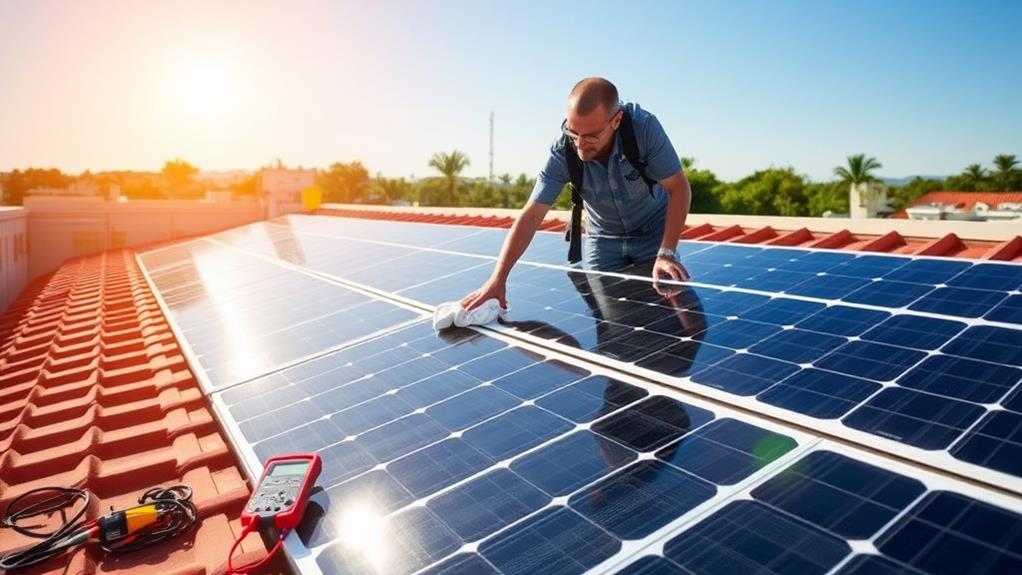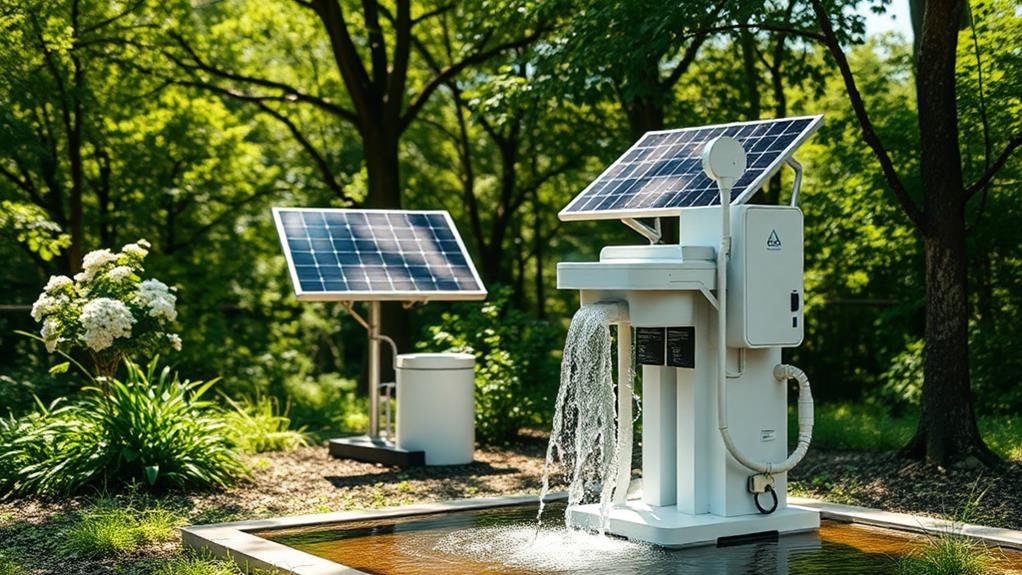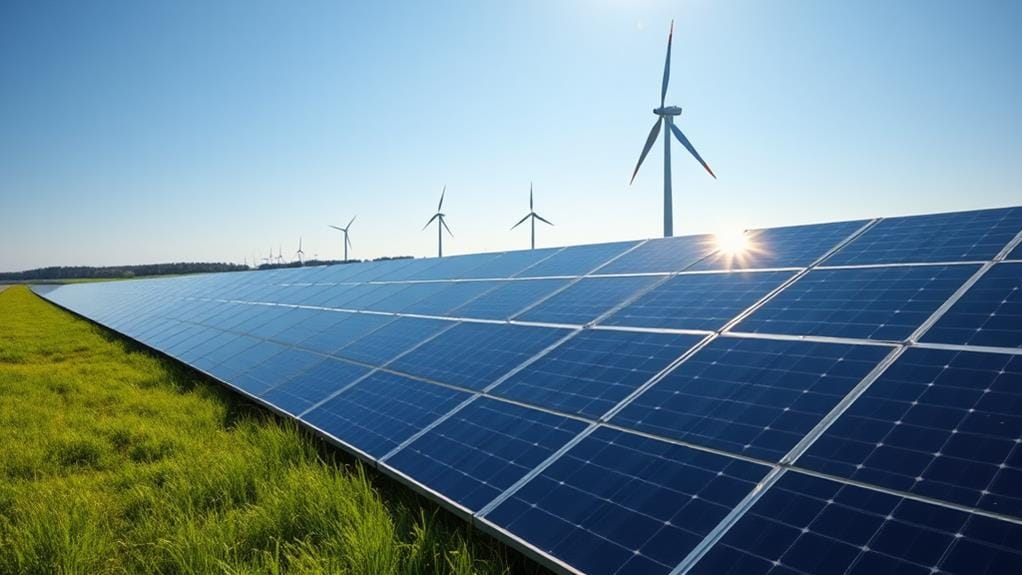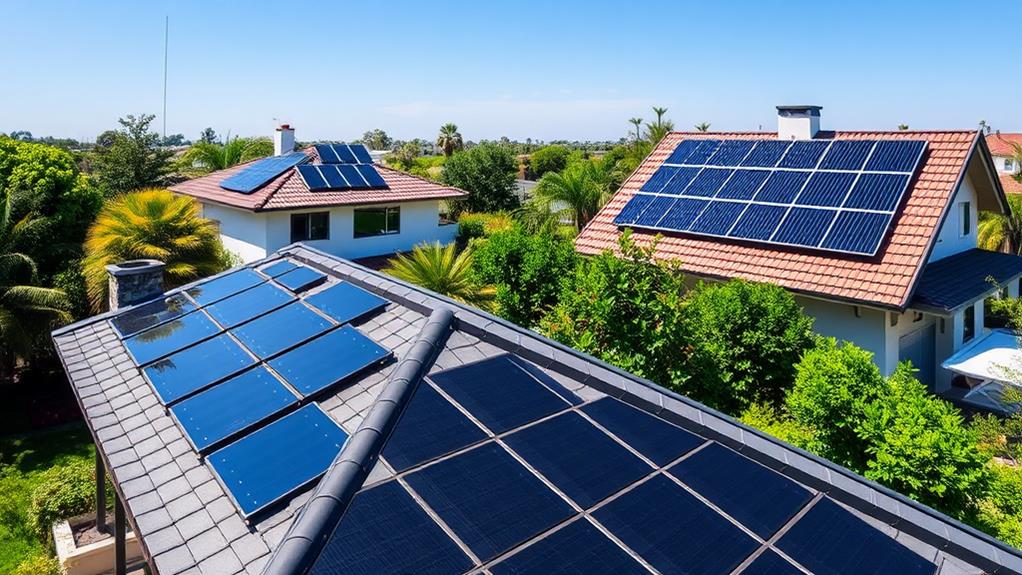When considering the best solar energy storage options, we find that lithium-ion batteries are highly favored due to their high energy density, efficiency of up to 95%, and lifespan of 10-15 years, with costs around $300 per kWh. Thermal energy storage systems, such as molten salt or water-based solutions, offer efficiency levels nearing 90%, making them viable for large-scale applications. Additionally, mechanical systems like pumped hydro and compressed air energy storage provide significant capacity and flexibility. Each option’s selection should balance power ratings, lifespan, and safety features to optimize performance. Further insights on these technologies await exploration.
Key Takeaways
- Lithium-Ion Batteries: Offer high energy density, efficiency up to 95%, and a lifespan of 10-15 years, making them ideal for residential use.
- Thermal Energy Storage: Systems like molten salt achieve up to 90% efficiency, providing reliable energy supply in solar power plants after sunset.
- Pumped Hydro Storage: The most widely used storage method, effectively balancing supply and demand with over 160 GW capacity globally.
- Flow Batteries: Gaining traction for commercial applications due to their scalability and suitability for long-duration energy discharge.
- Emerging Technologies: Innovations like solid-state and gravity-based storage enhance safety, longevity, and efficiency in renewable energy systems.
Overview of Solar Energy Storage
When we think about solar energy, it’s important to recognize the pivotal role of energy storage systems. These systems are essential for capturing excess energy generated during peak sunlight hours, ensuring we have power available during non-sunny periods. As the market for solar energy storage is projected to exceed $10 billion by 2026, we see a growing demand for technologies that enhance grid stability through renewable energy integration. Among these, lithium-ion batteries stand out due to their high energy density and efficiency. Additionally, thermal energy storage systems, utilizing mediums like water or molten salt, achieve impressive efficiency rates, while pumped hydro storage represents a widely used mechanical method, effectively balancing electricity supply and demand for reliable backup power.
Types of Battery Storage

As we explore the various types of battery storage for solar energy, it is crucial to understand the advantages of lithium-ion batteries, which dominate the market due to their high energy density and longevity, typically lasting 10-15 years. In contrast, lead-acid batteries, while more affordable initially, offer shorter lifespans of 3-7 years and lower efficiency, making them less suitable for long-term applications. Additionally, we should consider emerging storage technologies, such as solid-state and flow batteries, which promise advancements in safety and scalability, albeit at a higher cost and with varying availability in the current market.
Lithium-Ion Battery Advantages
Lithium-ion batteries stand out as the leading choice for solar energy storage, thanks to their impressive energy density and efficiency. These batteries offer a high energy density, allowing for compact energy storage solutions, which is essential for residential applications. Their longer lifespan, typically between 10 to 15 years, provides a substantial return on investment compared to traditional lead-acid batteries that last only 3 to 5 years. With a depth of discharge (DoD) of up to 90-95%, lithium-ion batteries allow us to utilize more of the stored energy, optimizing efficiency, which can reach up to 95%. In addition, the significant decrease in costs, now around $300 per kWh, enhances their accessibility, making lithium-ion batteries an appealing choice for effective solar energy storage solutions.
Lead-Acid Battery Characteristics
Although they may not offer the longevity or efficiency of lithium-ion batteries, lead-acid batteries have been a reliable choice for solar energy storage for many years. Their lower initial costs make them particularly appealing for those of us seeking budget-friendly solutions in solar systems. However, it is essential to recognize that lead-acid batteries generally have a shorter lifespan, averaging around 3 to 5 years, compared to lithium-ion’s 15 years or more. They operate at a lower depth of discharge, typically around 50%, meaning only half of their stored energy should be utilized to prolong their lifespan. Additionally, these batteries are bulkier and heavier, which can limit placement options, yet they continue to serve as a viable energy storage solution in the renewable energy landscape.
Emerging Storage Technologies
While lead-acid batteries have served us well in the past, the landscape of solar energy storage is evolving rapidly with the advent of emerging technologies. Today, lithium-ion batteries dominate due to their high energy density and efficiency rates, making them a top choice for residential systems. However, flow batteries are gaining traction for larger installations, offering scalability and extended discharge durations, consequently enhancing renewable energy storage capabilities. Solid-state batteries are also on the rise, promising improved safety, longevity, and energy density thanks to their solid electrolyte composition. Additionally, thermal energy storage systems utilize materials like molten salt to store heat effectively, achieving efficiency rates up to 90%, thereby ensuring electricity generation even during nighttime hours.
Thermal Energy Storage Solutions

As we explore thermal energy storage solutions, we should consider the various types available, including water storage and molten salt systems, which effectively capture and retain heat generated from solar energy. These systems can achieve impressive efficiencies of up to 90%, making them particularly suitable for large-scale applications in concentrated solar power (CSP) plants, where they can provide a reliable energy supply even after sunset. Additionally, understanding their applications in solar power will highlight how these technologies can help balance energy supply and demand, especially during peak consumption times, ultimately enhancing grid resilience.
Types of Thermal Storage
Thermal energy storage systems play an essential role in optimizing solar power utilization, allowing us to harness excess heat generated during sunny days for use when the sun isn’t shining. Among the various types of thermal storage, we often see the following options:
| Type | Medium | Key Benefits |
|---|---|---|
| Molten Salt | Salt | High energy retention |
| Water Storage | Water | Cost-effective and scalable |
| Phase Change Materials | PCM | Long-duration storage |
In concentrated solar power (CSP) plants, thermal storage enables us to generate electricity even after sunset through steam turbine operation. This capability provides significant backup power during peak demand, enhancing grid balance and reducing reliance on fossil fuels, making thermal energy storage a crucial solution for utility-scale applications.
Efficiency of Thermal Systems
The efficiency of thermal energy storage systems is a game-changer for maximizing solar power utilization. Achieving efficiency levels of up to 90%, these systems effectively store heat generated from solar power, utilizing mediums like molten salt or water. This stored thermal energy can later be converted into electricity, ensuring consistent energy supply even during periods of low solar generation, such as nighttime or cloudy days. Concentrated solar power (CSP) plants particularly benefit from thermal energy storage, enabling reliable electricity generation after sunset. Additionally, the cost-effectiveness of these systems improves with larger installations, making them ideal for utility-scale applications. By mitigating the intermittency of solar power, thermal energy storage enhances the overall reliability and sustainability of renewable energy solutions.
Applications in Solar Power
Solar energy storage solutions play an essential role in enhancing the effectiveness of solar power systems. Thermal energy storage, particularly through systems like molten salt, achieves efficiency rates of up to 90%, allowing us to store excess heat generated by solar panels during the day for nighttime electricity production. Concentrated solar power (CSP) plants utilize this technology to maintain energy production after sunset, converting stored heat into steam to drive turbines. Water, with its high specific heat capacity, serves as an effective thermal storage medium. As we explore emerging technologies, such as phase change materials, we find potential for improved energy retention and release characteristics, thereby expanding the applications of thermal storage in addressing energy demand and complementing battery storage solutions.
Mechanical Energy Storage Systems
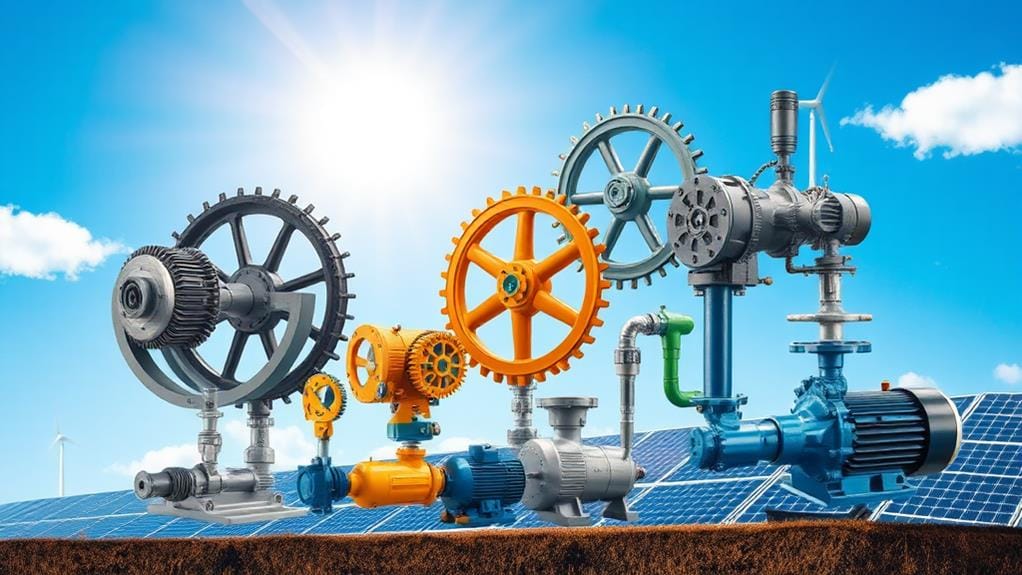
Mechanical energy storage systems offer innovative solutions for harnessing surplus electrical energy, converting it into mechanical energy for later use. Among these, pumped hydro storage stands out as the most widely employed method, utilizing two water reservoirs at different elevations for efficient electricity generation. Compressed air energy storage, which compresses air in underground caverns, allows us to release energy through turbines when needed, boasting estimated costs of around $105 per kWh. Flywheel storage systems, while providing rapid energy discharge, typically have limited capacity. Additionally, gravity-based energy storage systems lift heavy weights to store energy, offering a unique approach without geographical constraints. Collectively, these mechanical energy storage solutions present high energy return on investment, making them ideal for large-scale energy storage within the renewable energy sector.
Advantages of Energy Storage
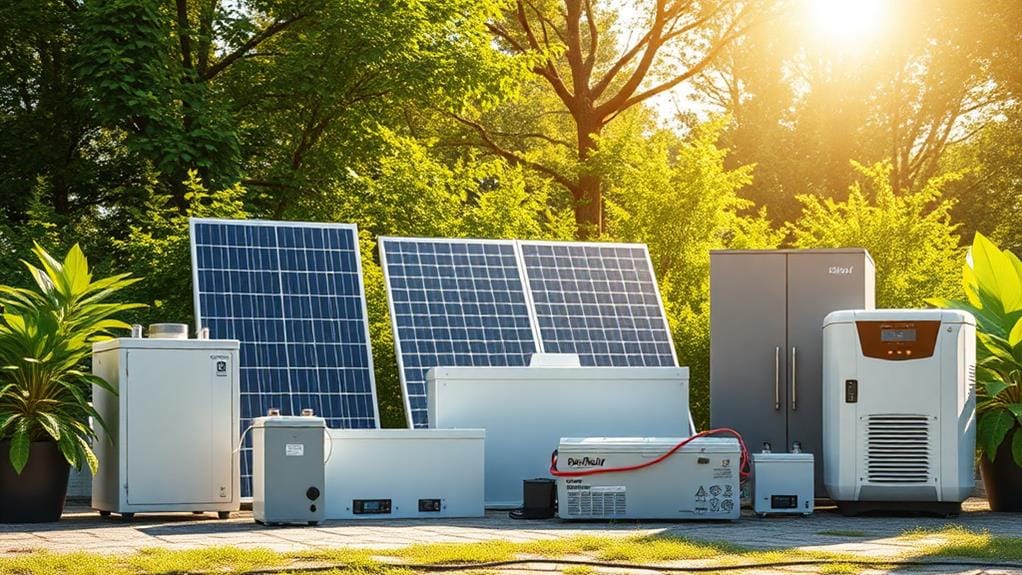
Numerous advantages come with energy storage systems, particularly when paired with solar technology. These systems not only enhance the utility of solar energy but also provide significant benefits that resonate with our collective goals for sustainability and efficiency.
- They enable us to reduce dependency on the grid, ensuring that we can use solar energy even during non-sunny periods.
- By lowering electricity bills, we can store energy during low-demand times and utilize it when prices peak, creating financial savings.
- Energy storage enhances resilience against power outages, maintaining power supply for critical services during emergencies.
With federal incentives now at 30% for solar and standalone storage, adopting these renewable energy solutions has never been more economically viable or appealing for us all.
Key Factors for Selection
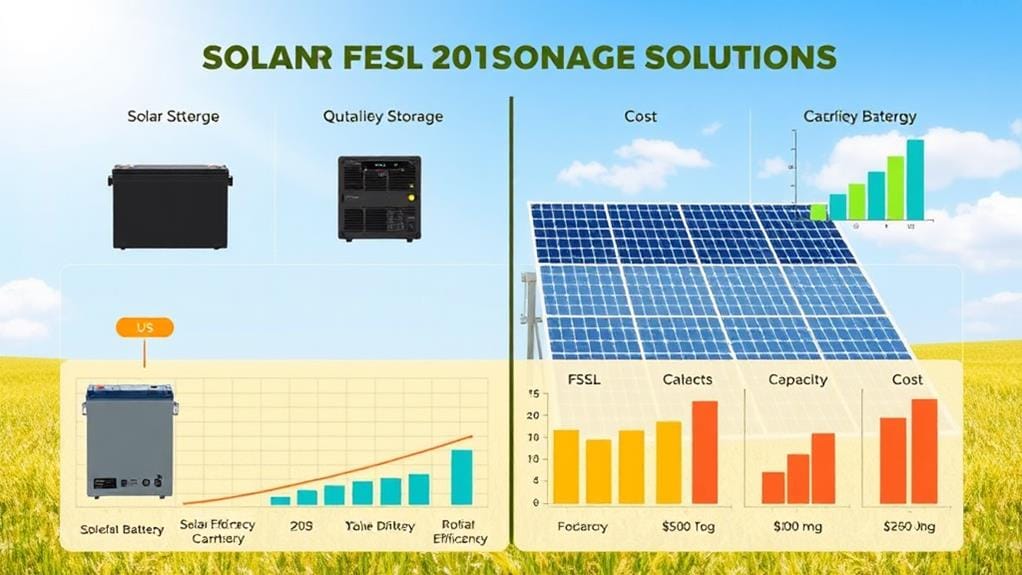
When choosing the right energy storage system, we need to contemplate several key factors that can considerably impact our overall satisfaction and efficiency. The power rating and usable capacity of the system are essential, as they dictate how much energy can be stored and retrieved. Roundtrip efficiency is critical too, influencing our overall energy use. While lithium-ion batteries offer longer lifespans of 15-20 years and better warranties compared to lead-acid batteries, their higher upfront cost may be a concern. We should also consider safety features and environmental impact, as LiFePO4 batteries provide enhanced thermal stability. Finally, the choice between AC-coupled and DC-coupled systems affects design flexibility and energy conversion efficiency, ultimately shaping our long-term investment.
Future Trends in Storage Technology
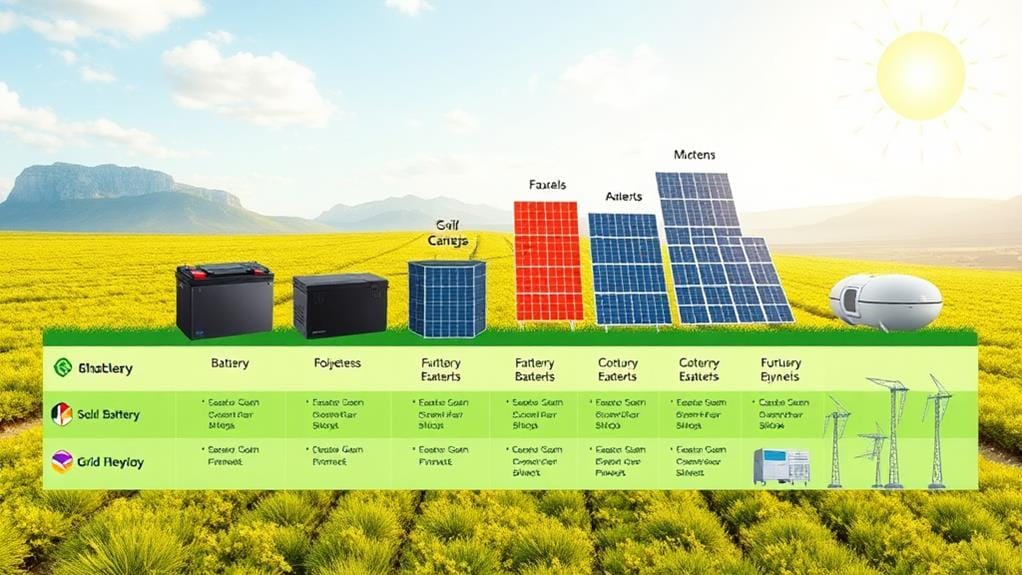
The future of energy storage technology holds exciting possibilities that promise to reshape how we harness and utilize renewable energy. As we look ahead, several trends are emerging in this dynamic landscape:
- Cost Reductions in Lithium-Ion Batteries: Ongoing advancements in battery technology are projected to lower prices, making these systems more accessible by 2025.
- Growth of Hydrogen Storage: This versatile solution is gaining traction for long-term energy storage, particularly when integrated with renewable energy systems.
- Integration of Smart Grid Technologies: These technologies will enhance energy management, allowing for real-time monitoring and optimization, thereby improving grid resilience.
With policy incentives and hybrid storage systems also on the rise, we stand at the threshold of a transformative era in energy storage solutions.
Practical Applications of Storage Solutions
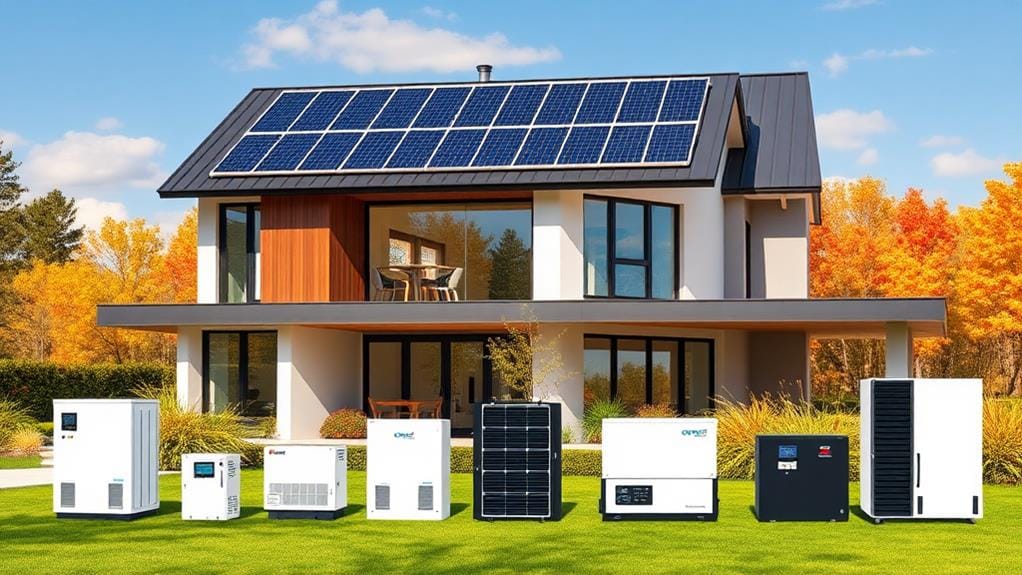
As we embrace the future of energy storage technology, it’s important to explore how these advancements can be applied in real-world scenarios. Lithium-ion batteries have become the go-to for residential storage due to their efficiency, lifespan of 15-30 years, and falling prices, enhancing energy management for homeowners utilizing solar PV. For commercial applications, flow batteries provide scalability and long-duration discharge, while thermal energy storage systems, like molten salt, can achieve up to 90% efficiency in concentrated solar power plants. Pumped hydro storage remains the leading method globally, with over 160 GW capacity, facilitating effective energy management during peak demand. Additionally, compressed air storage systems offer a cost-effective solution at approximately $105/kWh, maximizing existing infrastructure for energy release when needed.
Frequently Asked Questions
What Is the Best Way to Store Solar Energy?
When we think about the best way to store solar energy, we see lithium-ion batteries, flow batteries, and thermal storage as great options. Together, they enhance efficiency and support grid integration for off-grid solutions.
What Is Solar Energy Most Effectively Stored In?
Like a treasure chest for our energy, we find solar batteries, thermal storage, and pumped hydro as effective solutions. Together, we can explore flywheel, hydrogen, and supercapacitor options, enhancing grid integration and demand response for our future.
What Is the Best Type of Solar Energy?
When we think about the best type of solar energy, we consider solar panel efficiency, renewable energy incentives, and advancements in photovoltaic technology that enhance energy independence and clean energy solutions within the evolving solar market trends.
What Are the Different Types of Solar Energy Storage?
When exploring different types of solar energy storage, we’ve got battery technologies like lithium-ion, thermal storage solutions, pumped hydro, flywheel systems, and even compressed air options. Each offers unique benefits for our energy needs.


